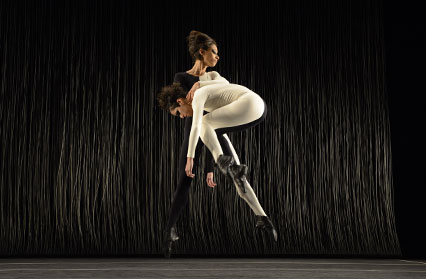Wales Millennium Centre, Cardiff
Next year will mark the 40th anniversary, not only of the conception of Grupo Corpo, but of a whole new style of dance. Founded in 1975 by the children of the Pederneiras family, they sought to create a new language by infusing the grace and beauty of classical ballet with the Brazilian passion and fire of Latin dance. The result is spectacular.
Two contrasting pieces yield an hour and a half of pure pleasure – this is escapism at its best. As the theatre falls into complete darkness, Sem Mim (Without Me) opens with the nineteen dancers taking their first steps onto the stage; each foot placed with absolute precision yet emerging as a breath-taking spectacle of effortless fluidity. Focusing on the longing of the women who wait upon the shores of The Sea of Vigo, uncertain as to whether their lovers will return to them, the piece ebbs and flows with the tides of hope and despair.
The highlight of the first piece and perhaps even the whole show arises with an emotional duet as the netting previously suspended above the stage descends upon the two dancers, creating a perfect setting which feels beautifully intimate yet is still easily visible for the audience. Incredibly moving and filled with measured movements interspersed with spectacular lifts, this is a perfect showcase of the powerful strength and graceful elegance these dancers possess.
The English translation of Grupo Corpo is ‘Body Group’ and rarely has a dance company been so aptly named. The nineteen dancers are practically indistinguishable from one another in terms of both their level of performance and technical skill. The entire dance troupe moves in perfect synchronicity, creating a seemingly infinite and mesmerising sea of movement. The opening of the second piece, Parabelo, demonstrated this perfectly. As the dancers sat, slightly raised from the floor with their weight balanced on the palms of their hands and balls of their feet, bathed in a deep red light, each movement dictated by the thrumming beat of the bass, a sinister almost spider-like creation came to life, a group of dancers creating a single body.
Colour was an integral part of the evening’s performance, from the bold carnival costumes in Parabelo and the intricate patterns in Sem Mim, to the superb lighting which accompanied each change of tone and atmosphere throughout the night. The shimmering costumes in Sem Min were outstanding, each a perfect fit to capture every subtle shift of the dancer’s body, and dyed to match the skin colour of each dancer which, combined with the lighting, created the illusion of a glittering skin.
The music itself was almost an experience on its own– there were so many diverse and unique melodies throughout the two pieces. The first was set to the original score composed by Carlos Núñez and José Miguel Wisnik which, although fiercely Brazilian, contained some very recognisable and surprising Celtic influences. At the end of the performance the audience were invited to remain for a Q & A session with two of the dancers which revealed some interesting insights into the language of Grupo Corpo.
The dancers learn the unique style (or language as it is thought of amongst the company) through rehearsals only. There are no classes or lessons to teach them how to master this fusion of ballet and Latin dance, and they are continuously learning whilst on stage. To learn that such an exclusive style is not taught but simply felt and picked up naturally, yet is transformed into such a technically flawless performance is astounding. It is also interesting to hear that, although the dance seems effortless and is so lyrical, the dancers note that to perform it is very mathematical – they are constantly counting from the very first to the very last step. They share an inside joke that is used frequently amongst the dancers which roughly translates to ‘If you miss a count in this show you catch up in the next one.’
Drop everything and immerse yourself in the beautiful language of Grupo Corpo.
Photo Credit: Jose luiz Pederneiras












